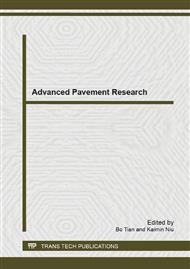p.42
p.51
p.56
p.64
p.70
p.75
p.81
p.90
p.97
Interaction between Slag and Clinker during Cement Hydration Process
Abstract:
In order to investigate the activity of different original slags and the coupled relation between the slag and the clinker, the simplified slag cement system was designed in the experiment, in which clinker was replaced by lime.The reactional degree of slag in cement was determined through using chemical combined water content method, and the hydration processs were determined through using DSC-TGA. The results showed that for the different original slags, the destruction and rebuilding process of their microstructure were important to distinguish the activity of slags. And the process of slag hydration mainly experienced two stages, including microstructure destruction at early ages and microstucture rebuilding at later ages. And the variation of Calcium hydroxide content in cement indicated the interaction between the slag and clinker, and slag may improve the clinker hydration velocity.
Info:
Periodical:
Pages:
70-74
Citation:
Online since:
December 2013
Authors:
Keywords:
Price:
Сopyright:
© 2014 Trans Tech Publications Ltd. All Rights Reserved
Share:
Citation:


